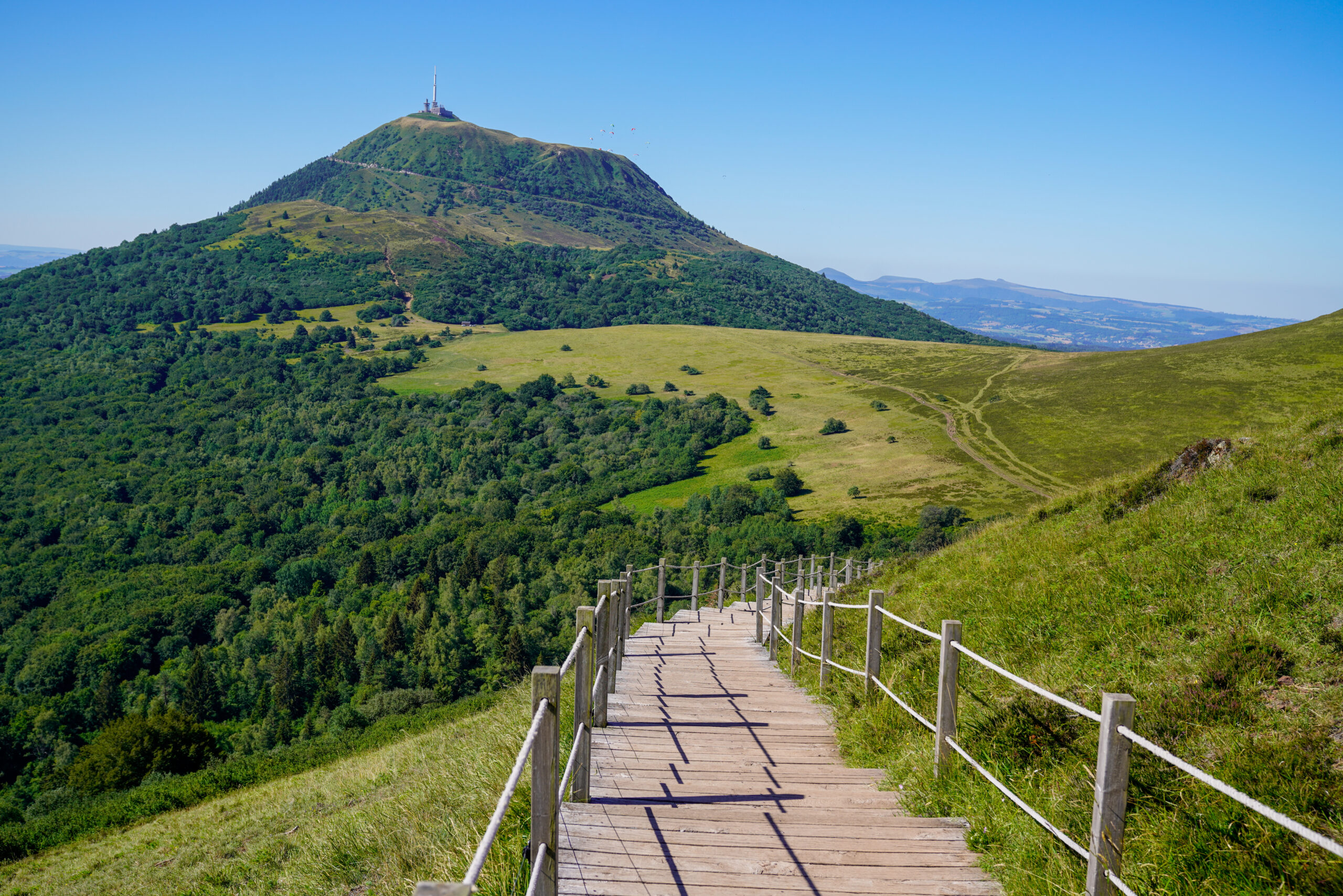From the ancient volcanoes of the Puys mountain range to the gorges of the Sioule, the mountains of the Cantal and the magnificent lakes of the Auvergne, this region offers so many natural treasures that lovers of protected natural spaces will feel like they are in paradise here. The Regional Natural Parks of the Auvergne Volcanoes and Livradois-Forez invite you to go on long hikes.
The gorges of Chouvigny and Lake Chambon are ideal for canoe or kayak trips. And to recover after all this effort, nothing beats a wellness break in one of the spas in the region’s many health resorts. The Auvergne is an area with vast protected natural spaces that are ideal for numerous outdoor activities. The region is a dream destination for lovers of nature and hiking. In the heart of the Massif Central, set off to explore this lush and enchanting natural landscape with all its assets.
The Auvergne also has a remarkably rich architectural heritage; its castles, Romanesque churches, typical villages and towns with important architectural heritage such as Clermont-Ferrand, Le Puy-en-Velay, Montluçon, Moulins and Riom will enchant you!
And if you are interested in history and old stones, you should definitely visit the strongholds of heritage in Auvergne, including several abbeys, the medieval towns of Charroux, Murat and Salers or the castle of Murol.
Blesle
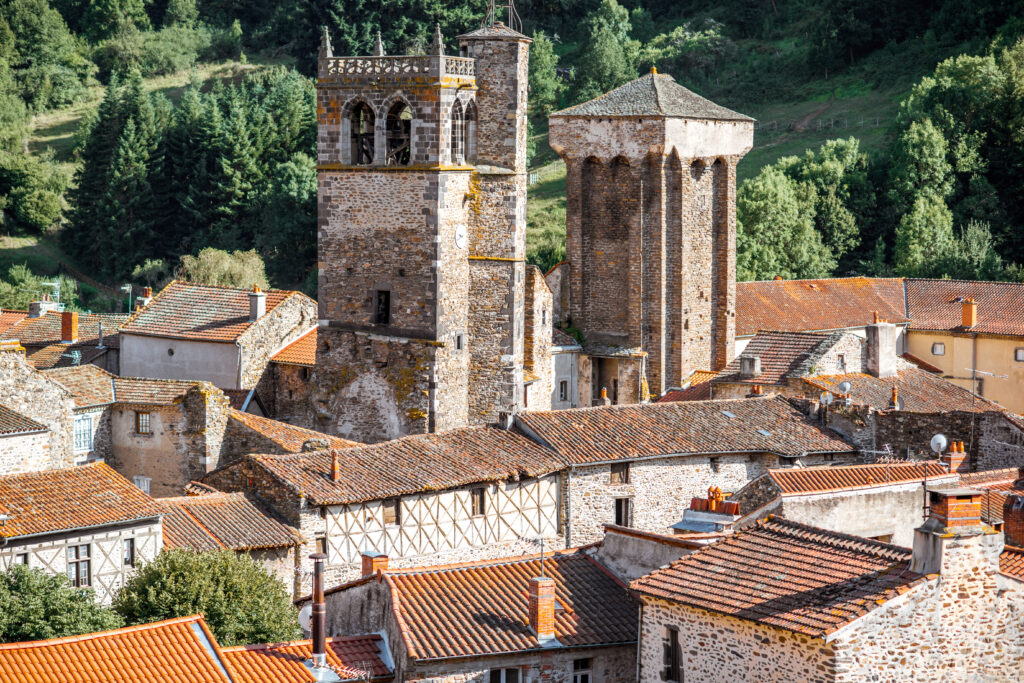
Blesle, one of the most beautiful villages in France, is a charming medieval village in the Haute-Loire in the green valley of the Alagnon, at the confluence of the Voireuze and Merdan rivers. The old town of Blesle, which lies in the shadow of a basalt rock, is best explored on foot. This way, you can enjoy the picturesque riverbanks, small bridges and picturesque atmosphere up close!
The architectural treasures of the medieval town include the Romanesque monastery church of Saint-Pierre, a listed historical monument with huge proportions and richly carved decorations.
Also worth seeing are the church treasure in the Sainte-Catherine chapel and the ladies’ choir; the Saint-Martin church, of which only the 14th century bell tower remains; the Mercoeur tower, also known as the Tower of the Twenty Angles, an imposing 13th century donjon that bears witness to the seigneurial power of the past; the medieval Massadou tower, also from the 13th century, which offers a beautiful view from its terrace; the old timber-framed houses and the old city walls…
Saint-Nectaire
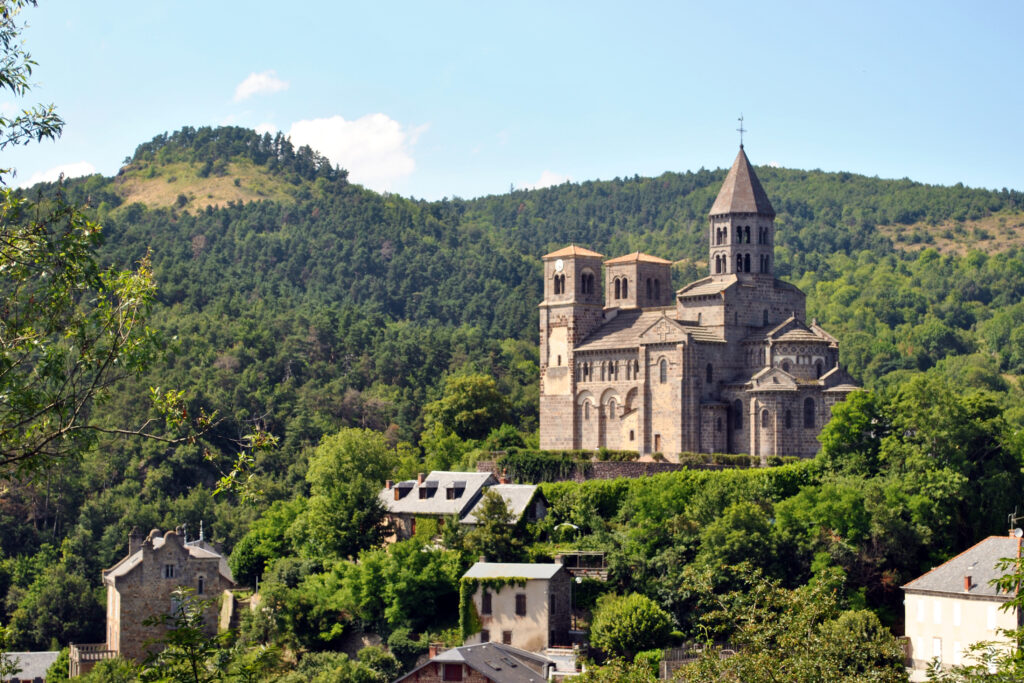
The small village of Saint-Nectaire, famous for its tasty cheese, is located in the Monts Dore massif and is dominated by its 12th century church, a very beautiful building with the typical Romanesque architecture of the Auvergne. The church was built by the monks of La Chaise-Dieu Abbey in honor of Saint Nectaire.
Inside this church, which is classified as a historical monument, you can admire around 103 fantastic figurative capitals and a treasure trove consisting in particular of the gilded copper bust of Saint Baudime and the Madonna of Mount Cornadore. Simply magical!
Below the church is Saint-Nectaire-le-Bas with its thermal station, which has more than forty springs, and the House of Saint Nectaire, which is dedicated to the famous creamy cheese with its subtle nutty flavor.
Volcans d’Auvergne Regional Park
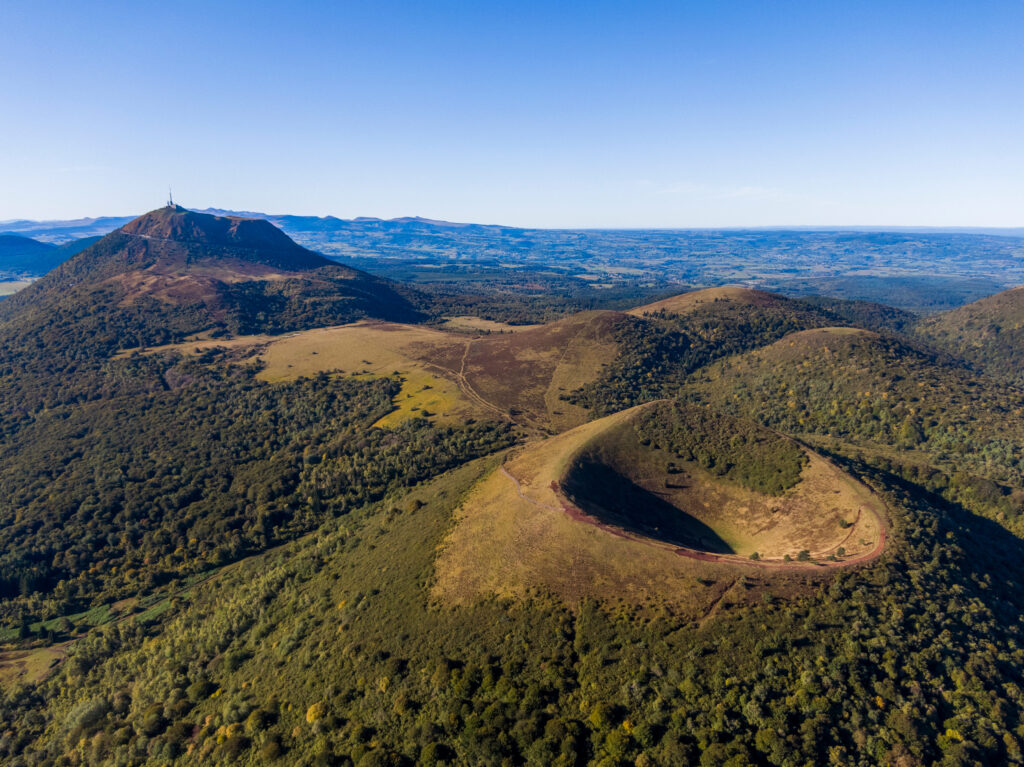
The approximately 80 smaller and larger volcanoes in the area of the Volcans d’Auvergne Regional Park have long been extinct and form a very fertile and lush green natural landscape with numerous mineral springs and crater lakes, some of which are very well-known.
The landscape of the Volcans d’Auvergne Regional Park with its numerous green, forested volcanic cones is spectacular and unique in Europe.
Monts Dômes is the name of the chain of 80 volcanoes, among which the Puy de Dôme stands out for its size and beauty, and not only that:
The world-famous natural mineral water “VOLVIC” has its source here, at the Clairvic spring at the foot of this extinct volcano.
Among the ancient volcanic cones of the Volcans d’Auvergne Regional Park, which are several million years old, the Puy de Sancy is also impressive with its height of 1885 meters. The extinct volcano is the highest peak in the French Massif Central and a very popular vacation destination in summer.
A paradise for hikers and cyclists, the Volcans d’Auvergne Regional Park offers magnificent hiking trails with unique Auvergne landscapes at high altitude, as well as an incredibly rich flora and fauna.
Lavaudieu
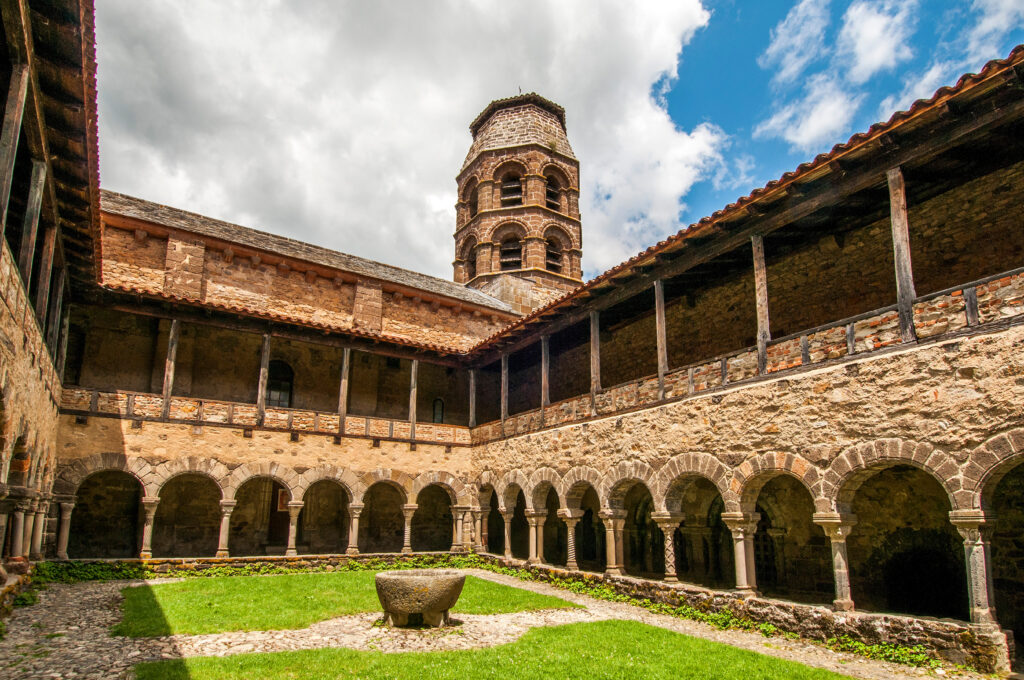
Lavaudieu, a village in the Haute-Loire, is one of the most beautiful villages in France and enjoys a particularly peaceful location on the banks of the Senouire, 9 km east of Brioude.
This enchanting village, famous for its Benedictine abbey, invites you to take a stroll in its charming atmosphere. Founded in the 11th century by Robert of Turlande, this abbey has a remarkably well-preserved Romanesque cloister, which is unique in Auvergne!
Another jewel of the abbey is the fantastic fresco in the refectory from the 12th century with Byzantine inspiration, which depicts the enthroned Christ above the Madonna and surrounded by the apostles. The abbey church with its octagonal bell tower has beautiful wall paintings from the 14th century Italian school.
Take the time to stroll through the alleyways and along the Senouire river to admire the stone houses with their round tiled roofs, the two-storey bell tower of Saint-André Abbey and the bridge that spans the river in several arches. An incredibly picturesque site…
To learn about everyday life in the past, visit the Museum of Popular Arts and Traditions of Haute-Loire, located in the former baker’s house, where you will discover a detailed reconstruction of a traditional Auvergne dwelling as well as many objects from everyday life and craftsmen of the past.
Murat
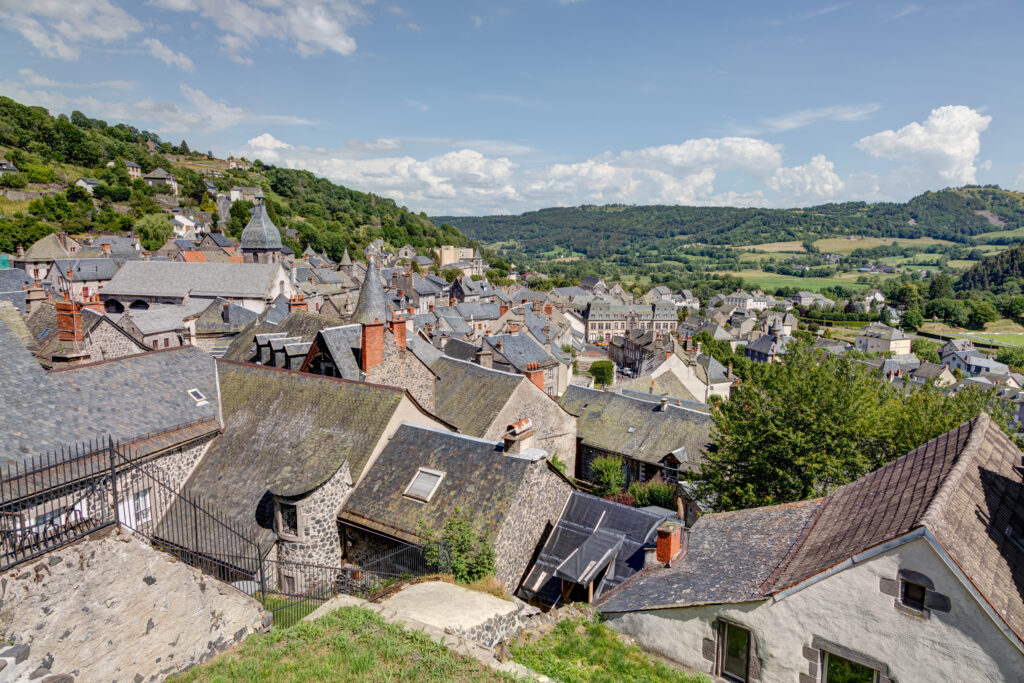
The municipality of Murat is located in the mid-high mountains at the foot of the Cantal mountains in the glacial valley of Alagnon and is a green vacation resort in the Massif Central. This hub in Haute-Auvergne is a picturesque medieval town nestled against the basalt rock of Bonnevie, which towers above the historic center.
In the Middle Ages, Murat was a fortified town and an important road junction, which was favorable for trade and thus led to many markets and fairs being held here. Two other volcanic hills, the rock of Bredons and the rock of Chastel-sur-Murat, border the municipal area.
Many old houses, some of which are listed as historical monuments, bear witness to the Middle Ages and the Renaissance.The Consular House, one of the jewels of Murat with its 15th century façade, the former 16th century bailiff’s house on the butcher’s square, the collegiate church of Notre-Dame-des-Oliviers, built between the 12th and 14th centuries, with statues and altarpieces from the 17th and 19th centuries, the Hurgon House in Bon-Secours street, are all must-sees as you stroll through the alleyways of the old town.
The old town with its gray roofs and the rock of Bonnevie, which lies in the shadow of the statue of Notre-Dame-de-Haute-Auvergne, form a beautiful overall picture in which natural materials from the region were used for almost all the buildings, such as wood, slate and volcanic stone.
Salers
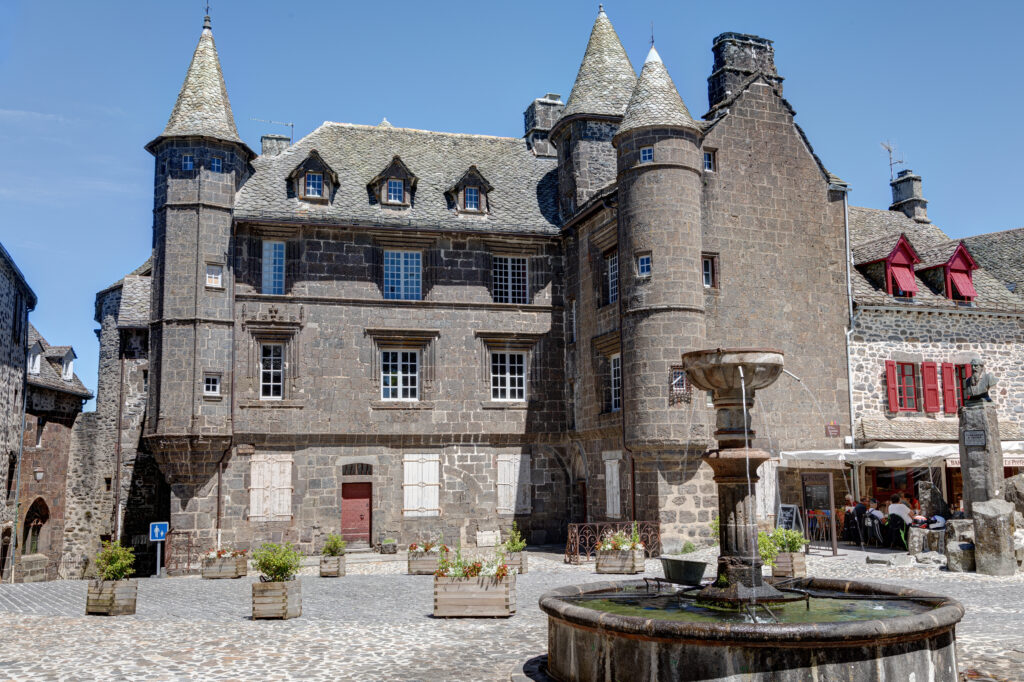
Above the Maronne Valley in the Auvergne Volcanoes Regional Nature Park is the enchanting medieval town of Salers, one of the most beautiful villages in France.
In the Middle Ages, the town was protected by a city wall, of which the gate of the keep and the Martille gate are the last remnants. The keep from the 15th century was once one of the four entrances to the town and was also known as the clock tower. Today it towers over a busy street with many stores.
At the end of the 15th century, Salers was given the status of bailiff’s capital of the high mountains in Auvergne: upper-class families settled here and had beautiful houses with turrets built: the house of Bargues with its balcony made of finely chiseled volcanic stone, the Renaissance house of Commander Mossier, also known as the Knights Templar house, with its Gothic-style gallery.
The urban architecture is characterized by the black volcanic stone and slate roofs. A real postcard decor, typical of the Tyssandier-d’Escous square, which is surrounded by Renaissance houses in the Haute-Auvergne style!
The town of Salers, which gave its name to a breed of cattle and is the symbol of an entire region, is also home to the famous Salers cheese: both specialties are celebrated in August as part of the Day of the Cow and the Cheese.
Vichy
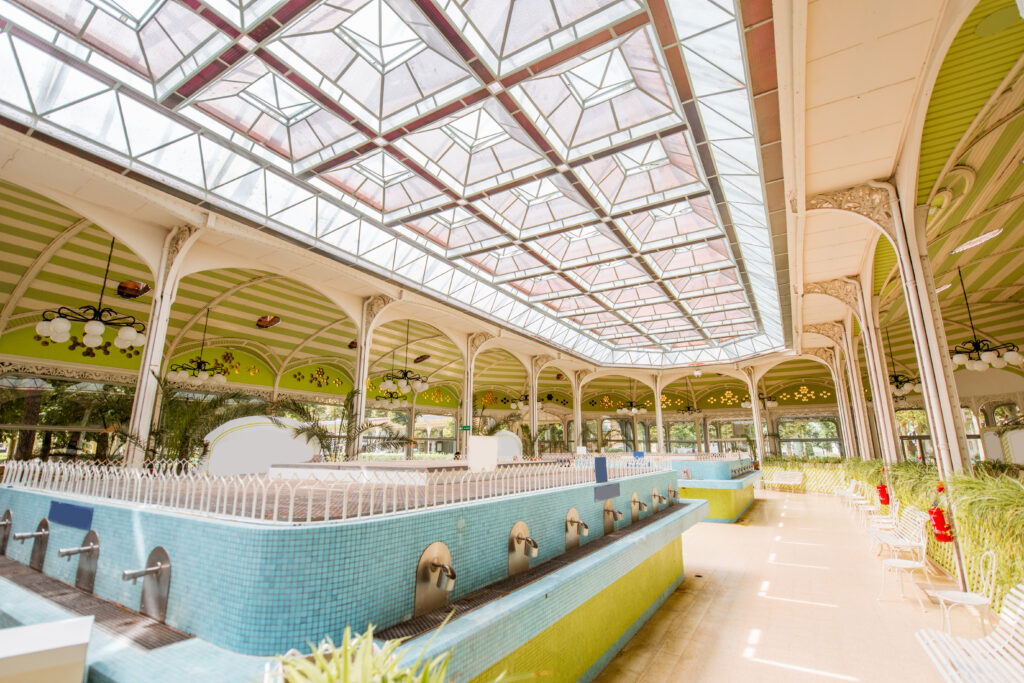
Known since Roman times for its beneficial and curative springs, the elegant town of Vichy, whose spas have been visited by famous personalities such as Napoleon III and the Marquise de Sévigné, has preserved many architectural treasures from the splendor of its time, which are both eclectic and refined.
The Second Empire, with the Palace of Congresses and the Opera House of 1865; the Park of Allier Napoleon III and the imperial vacation residences; the Beautiful Era with the Fountain Hall of 1902, the covered metal gallery of the Fountain Hall, the domed thermal baths, the Pavilion of Célestins and the villas and palaces of the Beautiful Era; Art Deco with the Valery Larbaud Cultural Center and the new Saint-Blaise Church of 1931.
This church, which has beautiful modern windows, is directly adjacent to the old Saint-Blaise church, inside which stands the particularly venerated statue of Our Lady of the Sick, a black Madonna from the 14th century that is said to have worked several miracles.
Take a stroll to discover the treasures of the Vichy spa, with the Hall of Springs, the six medicinal water springs, the Pavillon Célestins, where the famous Vichy spring is located, as well as the pleasant Allier Park or the Park of Springs and the Oriental-style baths.
Specializing in the treatment of digestive disorders, the domed thermal baths also offer fitness and weight loss cures.The Vichy Thermal Spa, a veritable temple of wellness and relaxation, is one of the largest spas in Europe and offers a true place of rest and relaxation with its swimming pool with medicinal water, its steam sauna, its saunas, its giant bubble bath and its beauty treatments.
Livradois-Forez
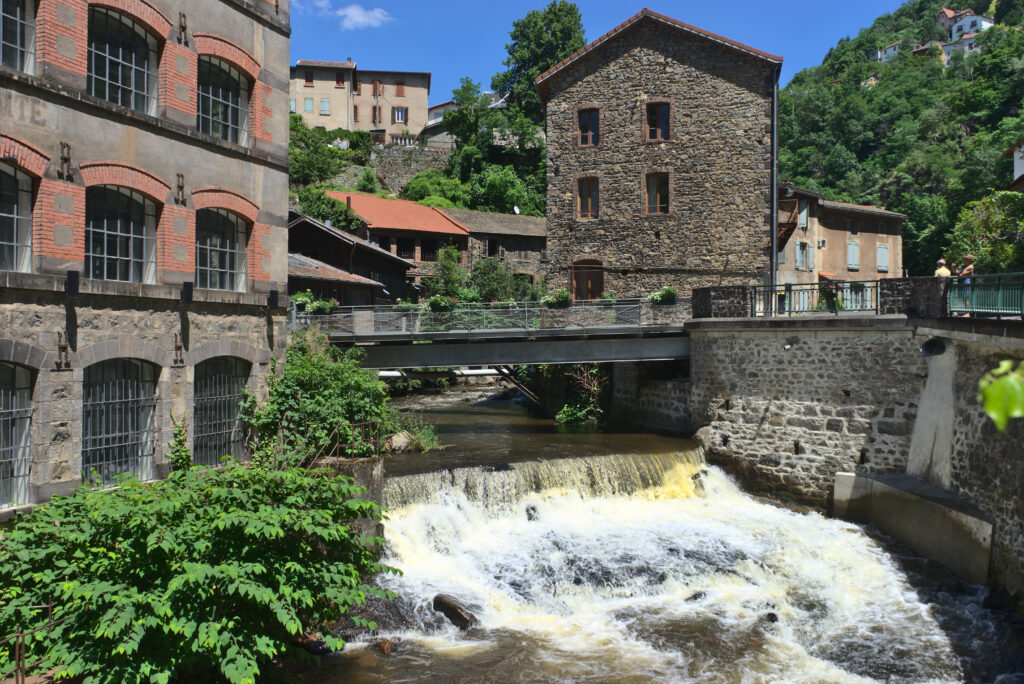
The regional nature park, which was founded in 1986 in the east of Auvergne, is one of the largest in France. It covers 322,000 hectares. Its 170 municipalities are home to 110,000 inhabitants in two départements.
The nature park borders Clermont-Ferrand and Vichy and includes Thiers, the capital of cutlery, the garlic stronghold of Billom, Ambert with its town hall in the same round shape as its famous blue cheese Fourme d’Ambert and La Chaise-Dieu with its former Benedictine abbey and its nationally famous music festival.
In three départements – Puy-de-Dôme, Haute-Loire and Loire – it has been protecting a fascinating kaleidoscope of low mountain landscapes since 1986, which have hardly come to the attention of tourism to date – and are therefore still wild, vast and pristine.
The Livradois-Forez landscape is part of the Massif Central and was formed during the Variscan mountain formation in the Palaeozoic era around 300 to 360 million years ago.
The most beautiful witness to these turbulent times is a volcano in the Devès mountains near Allègre: Mont Bar. It is 790,000 years old and surrounded by dense beech forest. At an altitude of 1,175 meters, it is home to a biotope that is unique in Europe: a peat bog in a crater.
Throughout the year, the Livradois-Forez surprises with the diversity of its flora. More than 2,500 plant species have been documented here, including rare orchids, medicinal herbs and endemic plants that are found nowhere else in the world.
Chateau de Murol
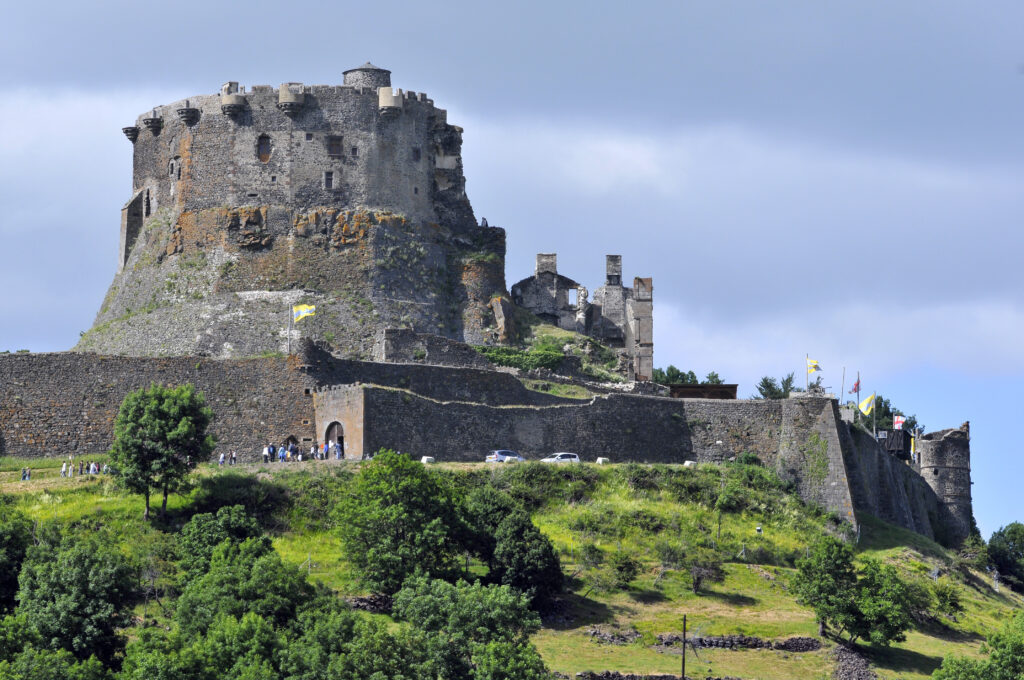
The town of Murol is located in a green 850 meters altitude in the valley Couze Chambon, on the eastern slopes of the Massif de Sancy, between wooded Tartaret volcano, the castle promontory Murol (listed monument) and the Puy de Bessolles peak at 1057 m altitude. Nearby, the Chambon lake and the Chaudefour valley (nature reserve).
High up on a basalt hill, the castle of Murol towers over the Couze valley and Lake Chambon. With its keep, walkway, fortified gate and towers, the castle resembles a medieval fortress. As a witness to the past centuries and numerous religious wars, the building complex is now classified as a historical monument.
The castle, which is also described in the novel “Jean de la Roche” by George Sand, is a jewel for all lovers of medieval architecture.
Le Puy-en-Velay
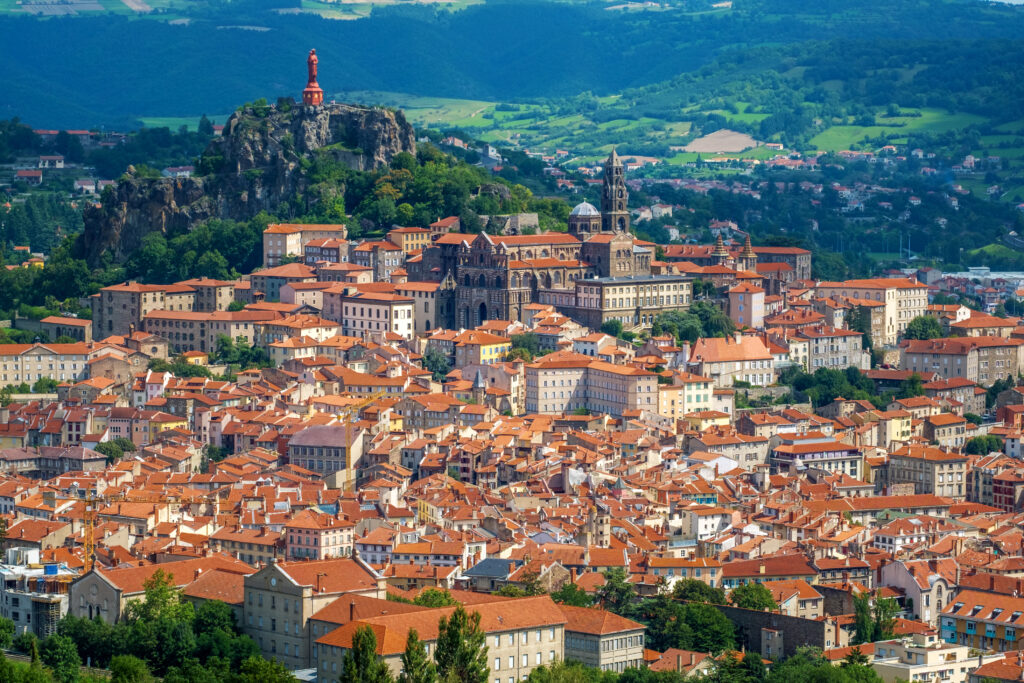
Le Puy-en-Velay, the capital of Haute-Loire, is located in the south-east of the Massif Central. This Auvergne town, which has been the starting point of the famous Via Podensis, one of the Camino de Santiago, since the Middle Ages, is a pilgrimage stronghold with its cathedral and Hôtel-Dieu, both of which are UNESCO World Heritage Sites.
Notre-Dame Cathedral, built at the foot of the Corneille Rock, an imposing volcanic rock that towers over the old town, is a remarkable example of Romanesque art with Carolingian, Byzantine and Moorish influences.
This enchanting building from the 11th and 12th centuries can be reached via picturesque, sloping alleyways in the lower town and a large staircase with 134 steps. Above the main altar stands the famous 17th-century Black Madonna, which is carried through the streets of the old town every year in a procession on August 15.
At the top of the Corneille Rock stands the Notre-Dame of France statue, a 19th century cast iron work by the sculptor Bonnassieux, made from the melted down cannons from the Battle of Sevastopol. From this platform, you can enjoy a fantastic view of the red roofs of the city!
The town of Le Puy-en-Velay is also famous for its bobbin lace, which, according to legend, was invented right here. You can find out more about this bobbin lace at the Crozatier Museum, which is located at the back of the pleasant Henry Vinay garden with its various plant species.
Moulins
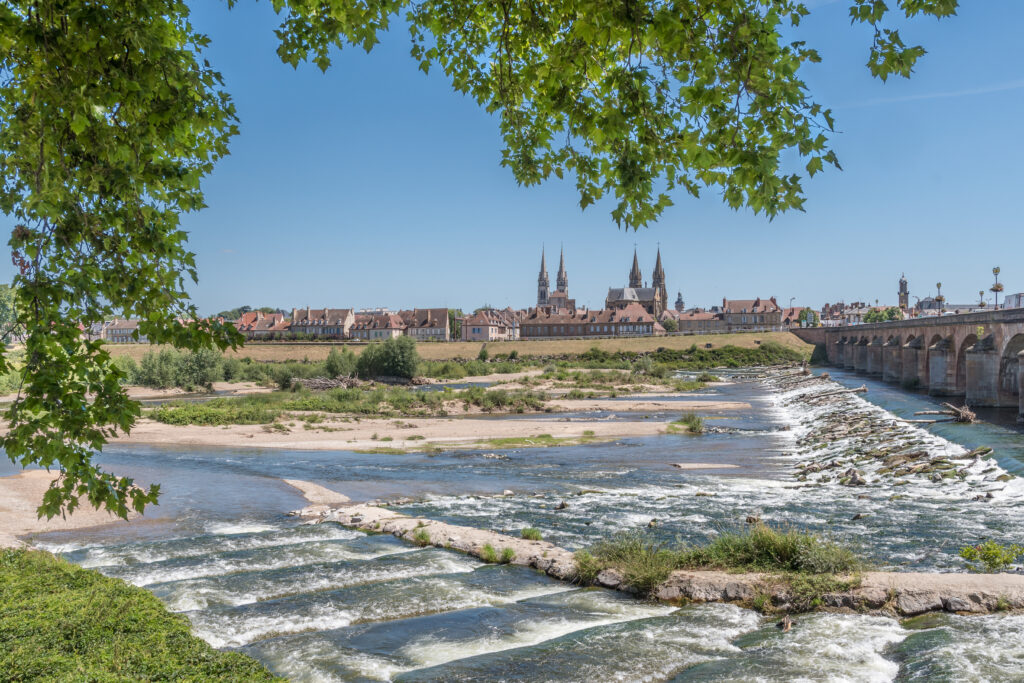
The city of art and history Moulins, historical capital of the province of Bourbonnais and prefecture of the Allier department, offers beautiful sights for all lovers of architectural and cultural heritage that bear witness to the glorious past of the former Duchy of Bourbon.
Many outstanding sights await visitors: Notre-Dame Cathedral with its beautiful altarpiece (triptych) by the Master of Moulins depicting the Coronation of the Virgin and its fantastic stained-glass windows from the 15th and 16th centuries; the Donjon “the Coronation of the Virgin” with its magnificent stained-glass windows from the 15th and 16th centuries.
The Donjon “the Badly Dressed”, a remnant of the former ducal residence; the 15th century watchtower with its clock spire; the old houses in the historic city center, including beautiful half-timbered houses, the pavilion of the Renaissance Anne de Beaujeu from the 15th and 16th centuries.
This pavilion is a remnant of the ducal palace and houses the Anne de Beaujeu Museum, which displays remarkable archaeological collections, medieval sculptures, Flemish, German and Austrian paintings and academic paintings from the 19th century
Also well worth a visit: the Museum des Bourbonnais with its collections on local history and the customs and trades of yesteryear; the National Center for Theatre and Film Costumes, housed in a former cavalry regiment building and displaying around 9,000 costumes, accessories and stage decorations!
Montlucon
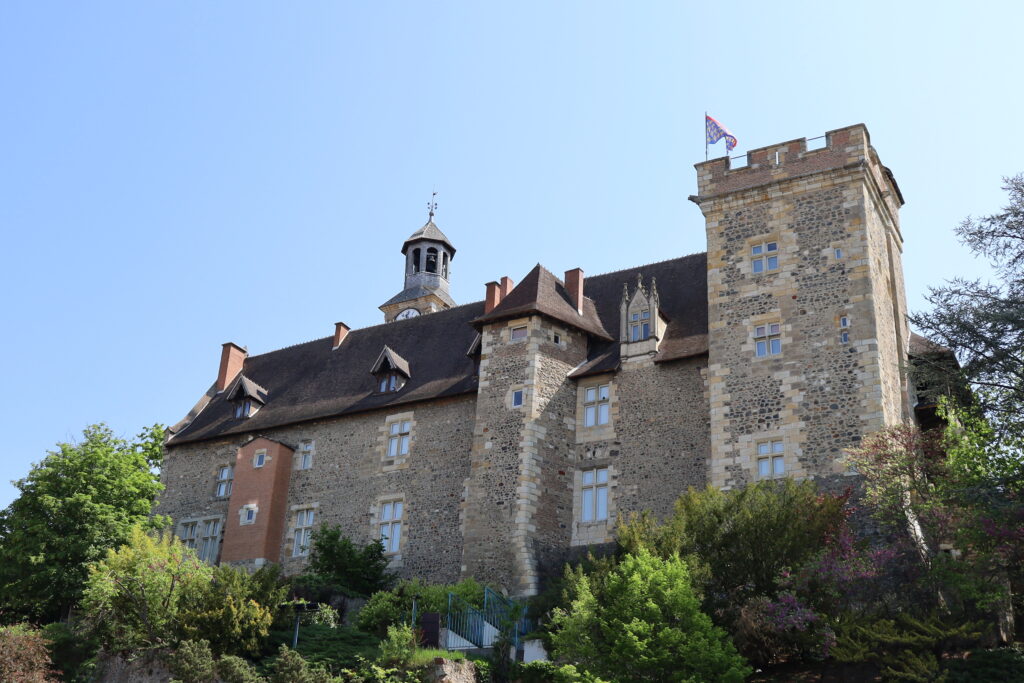
The old town winds around the castle of the Dukes of Bourbon, which is enthroned on a rocky outcrop above the River Cher.
Take to the heights and enjoy the panorama from the Esplanade Louis II de Bourbon. From here, you will realize the importance of the castle and its protective function for Montluçon.
The medieval town, which nestled around the castle, was protected by mighty walls. This wall, flanked by 40 towers, was pierced by 4 gates that gave access to the city.
The Boulevard de Courtais and Boulevard Carnot, which form a complete loop around the historic center, give you an idea of where the ramparts surrounded by moats once stood.
On your walk, you can admire beautiful half-timbered houses from the 15th and 16th centuries, immerse yourself in the tranquillity of the churches of Saint-Pierre and Notre-Dame or stroll in the shade of the city walls in the Jardin Wilson.
The narrow streets of the medieval town offer a charming stroll punctuated by beautiful half-timbered houses.
One after the other, you will discover the Notre Dame church, the 16th century mansions in the Rue de la Fontaine and the Saint Pierre district, whose church houses one of the most beautiful sculptures in France: the statue of Saint Magdalene, a listed monument.
Saint-Flour
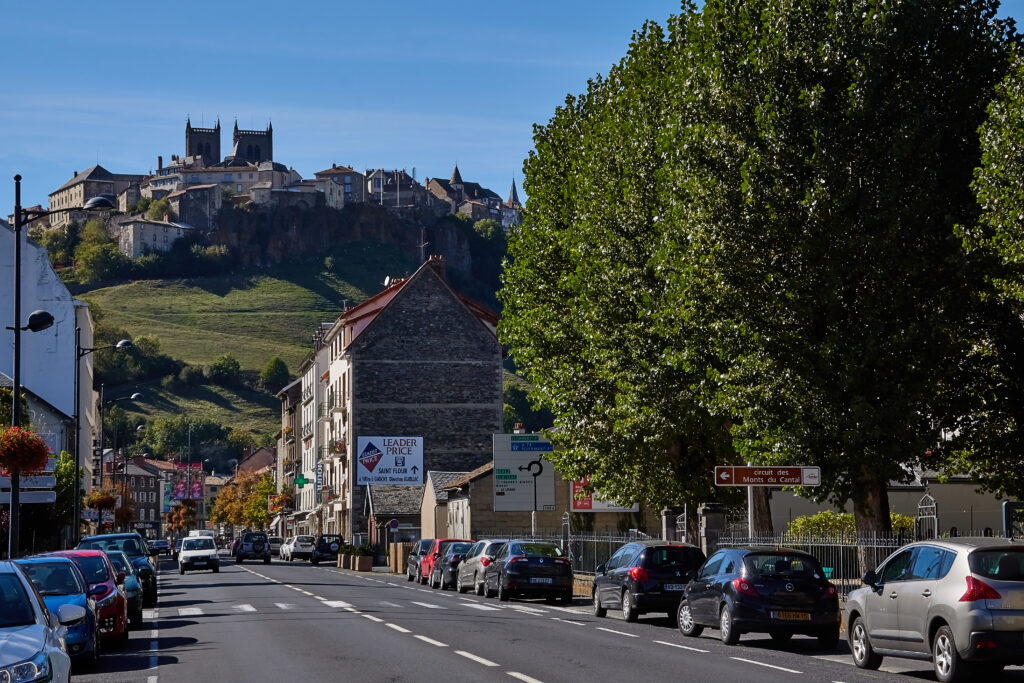
The town of Saint-Flour, which has been awarded the label of a land of art and history, is located where the Truyère gorges, the Cantal mountains and the Margeride meet. This thousand-year-old town on a rocky outcrop was built on the foothills of the largest stratovolcano in Europe. It has many historical treasures, some of which are closely linked to its past as the religious capital of Haute-Auvergne.
When you arrive in Saint-Flour, take the time to enjoy the beautiful view of the upper town, with its natural ramparts made of volcanic stone and its medieval fortifications. The visit to the old town takes you from picturesque alleyways to fortified gates as well as the 14th and 15th century Saint-Pierre Cathedral, a Gothic building made of black lava stone, famous for its large walnut Christ, the “Beautiful Black God”, which most likely dates back to the 12th century.
Near the cathedral, the terrace of the rocks on the former defensive wall with its orientation board offers you a beautiful panorama of the lower town and the mountains of the Margeride!
Be sure to make a detour to the former 17th-century bishop’s palace, which adjoins the cathedral and is now the Museum of Haute-Auvergne. There you will discover the popular art of the region with one of the finest collections of domestic and household furniture in France, religious works of art and archaeological collections.
Riom
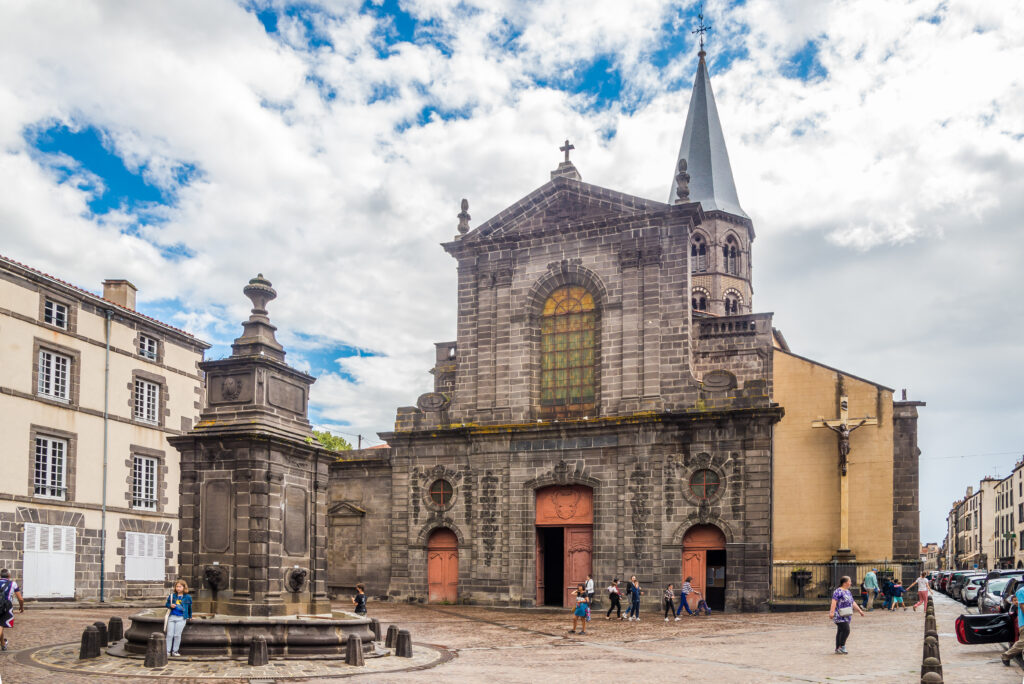
Riom, the former capital of the Duchy of Auvergne and an elegant city of art and history, still has many architectural remains from its precious past.
The 16th century town hall with its beautiful inner courtyard, the late Gothic-style Sainte-Chapelle church with its large 15th century stained glass windows, the Guymoneau town house and its richly decorated staircase, the clock tower with its beautiful panorama of the town’s rooftops and the surrounding area or the Notre-Dame-du-Marthuret church with its remarkable statue of the Madonna with bird are just some of the beautiful places that can be discovered during a stroll through the historic town center.
Also worth a visit is the Mandet Museum with its collections of paintings, sculptures and decorative art objects, goldsmiths’ objects and ceramics, as well as the Regional Museum of Auvergne, which is dedicated to the folk arts and traditions of Auvergne in the 19th century.
Clermont-Ferrand
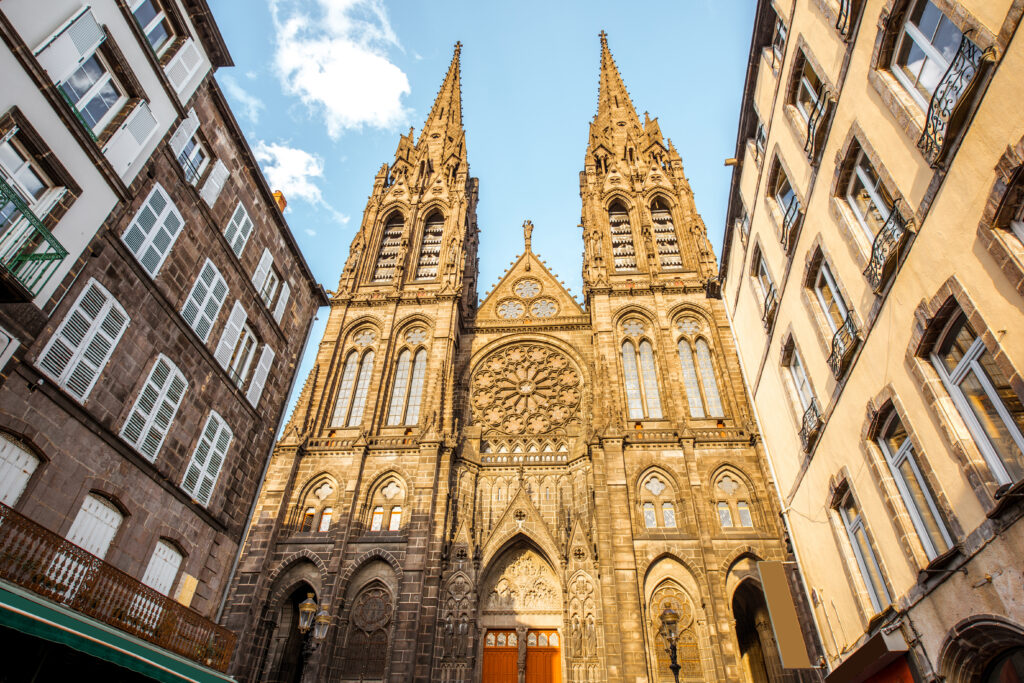
The picturesque old town is one of the oldest historical centers in France. It is not called the “village in the heart of the city” for nothing, because here you can really lose yourself in the winding streets surrounded by well-preserved town houses and beautiful fountains.
Take a stroll through the medieval-looking Montferrand district in the center of Clermont-Ferrand and discover numerous historical treasures, such as the Gothic cathedral Notre-Dame-de-l’Assomption, built from lava stone.
Discover other fascinating buildings made of black stone not far from the cathedral, such as the Hôtel de Chazerat in Blaise Pascal Street, which was named after the famous mathematician and philosopher. You can also experience the unique atmosphere in the small and large squares.
Another highlight of the old town is the Basilique Notre-Dame-du-Port, a UNESCO World Heritage Site, which is enchanting with its lovingly crafted capitals and imposing Romanesque-style choir. The Black Madonna in the crypt is admired by numerous pilgrims every year.
Place de Jaude is undoubtedly the beating heart of the old town. There is something for every taste on this large and lushly planted square: shopping enthusiasts can enjoy a wonderful stroll through the shopping center, a traditional French department store or the smaller stores. Those who prefer to watch the hustle and bustle while enjoying a café au lait can stop off at one of the charming cafés and bistros.

